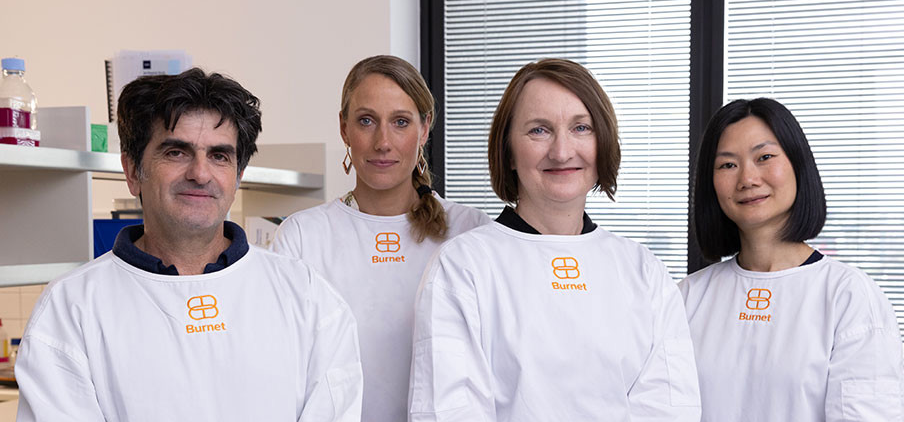- /
- Our work /
- Health themes /
- HIV

HIV
HIV, or human immunodeficiency virus, is a virus that attacks white blood cells in your body. Left untreated, HIV can damage your immune system, making it more difficult to fight off other illnesses. Although HIV can lead to AIDS, there are modern treatments used to prevent the progression of disease. The availability of antiretroviral treatment has transformed HIV from a fatal disease into a manageable chronic condition. Thanks to advances in care, HIV can be effectively treated to help people age well and thrive.
Our commitment to HIV research
Since our founding years in the 1980s, Burnet Institute has been at the forefront of HIV research. Today, we continue to lead with advocacy, community engagement and interdisciplinary research. Working together, we harness skills across basic science, public health and international development. This means generating new knowledge, but it also means implementing our findings with the communities that need it most.
We’re working on addressing the global challenge of HIV. Our work aims to:
- understand risk factors for acquiring HIV
- understand how HIV infects and persists within cells
- address inequities in prevention, treatment and care
- ensure funding for HIV is spent effectively
- develop new treatments for HIV
- eliminate mother-to-child transmission of HIV
- halt the emerging HIV epidemic in the Pacific
- support healthy ageing with HIV
- end the discrimination, stigma and neglect surrounding HIV and marginalised people.
Stories
View 35 more
Investing in communities to end HIV
Global HIV progress is at risk, and we must not look away, writes Professor Brendan Crabb AC.

Paul Dietze and his amazing technicolour HIV lab coat
Professor Paul Dietze has a unique memento from IAS2025, a custom-designed lab coat reimagined through the lens of #HIV science, fashion, and activism.

Integration of care in PNG a focus for NHMRC funding
Research into the increasing burden of non-communicable diseases and continuing high prevalence of tuberculosis and HIV in Papua New Guinea will benefit from new funding from the National Health and Medical Research Council.
About HIV
The HIV epidemic began in the 1980s, leading to the deaths of millions worldwide. Since then, the global HIV response has advanced significantly. With access to care, HIV is no longer fatal, but the virus still poses a challenge for health and wellbeing around the world.
HIV prevention and treatment
PrEP (pre-exposure prophylaxis) is a highly effective medication taken to reduce the risk of acquiring HIV. It's been widely available in Australia since 2016 and can be taken as a daily pill or around the time of sex (on-demand). There's also PEP (post-exposure prophylaxis), which is taken within 72 hours of potential exposure to the virus.
PrEP has been used by more than 80,000 Australians and its widespread uptake has led to major reductions in new HIV infections among gay and bisexual men over the past decade.
Through antiretroviral treatment (ART), people living with HIV can reduce their viral load until the virus is virtually undetectable. This protects them from AIDS-related disease and death. Once HIV is at undetectable levels, it can't be transmitted.
HIV around the world
Despite progress, treatment and care remain inaccessible for many. In 2023, more than a million people worldwide became newly infected with HIV. In the same year, more than 500,000 people died from AIDS-related illnesses. Cases persist in many parts of the world where it's difficult to access prevention, testing and treatment. This includes Sub-Saharan Africa, where young women accounted for most new HIV cases in 2023.
Recently, HIV infections have increased substantially in the Pacific. In Fiji and Papua New Guinea, cases have risen in recent years due to decreases in funding and new networks of transmission through injecting drug use.
HIV discrimination
Stigma and discrimination are major problems. In the 1980s, HIV and AIDS became associated with inaccurate racist, homophobic and xenophobic ideas. Today, people living with HIV continue to face bias and mistreatment. These issues can occur within healthcare as well as the workplace, social sphere and legal system. Existing inequalities, and social and political context, make it harder for people living with HIV to get the care they need.
HIV cure
At the moment, there is no universal cure for HIV. This makes it all the more important that people living with HIV are able to access treatment and care.
At Burnet, we’re working to find a cure for HIV.
Our achievements in HIV
Inventing a new monitoring test for HIV
Our researchers created the world's first equipment-free point-of-care CD4 test. CD4-positive cells are a type of white blood cell that reveals the effect of HIV. With the VISITECT® CD4 test, people living with HIV in hard-to-access regions can benefit from this transportable, low-cost test. Since 2020, the test has been approved by the World Health Organization for global use.
Discovering new ways to treat HIV
Our lab researchers have screened more than 600 'fragments', or tiny chemicals, to develop new antiviral treatments for HIV. Because viruses can mutate and adapt, we need ongoing research to update HIV drugs. With partners in industry and academia, we've developed therapeutics that target drug-resistant HIV.
Using lactic acid to prevent HIV
By examining bacteria and microorganisms that live in the vagina (‘vaginal microbiome’), our researchers discovered that lactic acid can reduce risk of HIV. Lactic acid, produced by a group of healthy bacteria, reduces genital inflammation and can kill viruses. It can act as a barrier against sexually transmitted infections. We're looking at ways this knowledge can be implemented using medications like gels.
Establishing community-led HIV testing in Victoria
In 2013, we worked with the Victorian AIDS Council (now Thorne Harbour Health) and Victorian Government to launch the PRONTO! service. It's Australia's first shop-front, peer-led HIV testing service for gay, bisexual and other men who have sex with men, and trans and gender diverse people. Since our trial, it's been established as an integral part of community health in Victoria.
Monitoring HIV treatment and health in Australia and Myanmar
Since 2008, we've partnered with the Kirby Institute and NRL Quality to lead the ACCESS surveillance network. Working with more than 100 clinics across Australia, this network tracks how HIV is tested and treated. This allows us to monitor progress toward HIV elimination. Through this network, we contribute data for national HIV surveillance reports.
We’ve also piloted an HIV sentinel surveillance network in Myanmar, to monitor the progress of individuals through HIV testing and treatment across a network of community and government services.
Developing free-to-use economic tools for HIV intervention
Our researchers used data modelling to create Optima HIV. This tool helps governments and agencies determine how to best use their resources to tackle HIV. Launched in 2012, it's since been used in countries across Europe, Asia, Africa and America.
Our approach to HIV and health equity
Health equity is at the core of our research at Burnet. As part of this, we work with priority populations who experience greater levels of harm and risk. Depending on their context, these groups of people may face persecution and discrimination. They may face barriers to affordable treatment and care. They include:
- people living or ageing with HIV
- young women
- gay, bisexual and other men who have sex with men
- trans and gender diverse people
- sex workers
- people who inject drugs
- people in remote or regional locations
- people in Australia without access to Medicare.
Co-design and peer-led work
Co-design is part of our approach to health equity. It means ‘nothing about us, without us.’ We work directly with the people most affected to understand their needs and challenges. We share responsibility in the direction of our work. This includes partnering with community organisations, such as Living Positive Victoria and Thorne Harbour Health.
Training and partnership in the Pacific
We partner to support HIV services in Papua New Guinea. This includes training health workers. It also includes working directly with people living with HIV. We're working on a peer counselling network, to support people beyond the clinic.
Biological research for prevention, treatment and cure
We work in the lab to develop new treatments for HIV and develop strategies for HIV cure. We’re also researching ways to help people with HIV live longer and healthier lives.
Our lab researchers examine the genital microbiome and how it relates to HIV. We also look at ways to put our findings into practice. This includes leading HIV clinical trials, such as a trial of lactic acid treatment with women in Australia.
Our researchers are searching for a cure for HIV. This includes work to identify natural ‘killer’ cells that can target and eliminate HIV-infected cells.
Surveillance and data
Through networks of clinics and laboratories (‘sentinel surveillance’), we gather de-identified data on HIV testing and treatment. This information can inform reports and help policymakers identify who is falling behind in HIV. The HIV data can also be used for research studies, cohort studies and analyses to inform responses to HIV.
Modelling and policy guidance
We work with governments and global health agencies to conduct epidemiological (disease-focused) and economic modelling. We use these models to project trends in HIV epidemics and analyse how these might change under different interventions or funding scenarios. We estimate how funding can be allocated to have the greatest impact.
Health promotion, advocacy and invitation
Creating tools, resources and services can help tackle inequality and discrimination. But this has little impact if people aren’t aware of these services or are apprehensive about seeking care. Part of our work is 'demand generation': bringing people in to access treatment and care.
Featured publications
Afucosylated broadly neutralizing antibodies targeting the HIV envelope elicit enhanced NK-cell–mediated cytotoxicity against HIV-infected CD4+ T-cell and macrophage targets
Journal of Leukocyte Biology
Olaf G. Wilhelm et al
HIV treatment-as-prevention and its effect on incidence of HIV among cisgender gay, bisexual, and other men who have sex with men in Australia: a 10-year longitudinal cohort study
The Lancet HIV
Denton Callander et al
Improvements in transition times through the HIV cascade of care among gay and bisexual men with a new HIV diagnosis in New South Wales and Victoria, Australia (2012–19): a longitudinal cohort study
The Lancet HIV
Daniela K van Santen et al
Impact of an international HIV funding crisis on HIV infections and mortality in low-income and middle-income countries: a modelling study
The Lancet HIV
Debra Ten Brink et al
Lactic acid from vaginal microbiota enhances cervicovaginal epithelial barrier integrity by promoting tight junction protein expression
Microbiome
David Jose Delgado-Diaz et al
Differences in HIV risk factors between South African adolescents and adult women and their association with sexually transmitted infections
Sexually Transmitted Infections
Pamela Mkhize et al
Our projects
View 53 more
Getting to the heart of cardiovascular disease in viral infections
This project aims to understand the mechanisms of how viral infections can potentiate the development of CVD, with a particular focus on the role monocytes may play in this process.
Friendly HIV services for young key populations in Bandung, Indonesia
The project designed and implemented a pilot project to decrease new HIV infections among young key populations in Bandung, Indonesia.

IndoPacLab
We aim to strengthen accurate, timely and scalable testing of COVID-19, HIV, TB and malaria.
Our working groups



Alcohol and Other Drugs group


Bioinformatics group



Burnet Diagnostics Initiative (BDI)


Diagnostic Markers in Chronic Immune Disorders group



Global Health: Policy, Practice and Community Action group



HIV and Sexually Transmitted Infection Prevention group



Immune Therapies group



Infection, Inflammation and Innate Immunity group



Infectious Diseases Clinical Research group



Modelling and Biostatistics group



Retroviral Biology and Antivirals group



Surveillance and Data Linkage group



Viral Entry and Vaccines group




